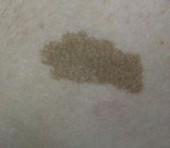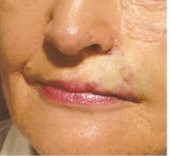The usual birthmarks one will encounter in aesthetic treatment is either:
- dark brown to black, such as the Naevus of Ota and the Café-au-lait spots, or
- red, such as the Strawberry Navei and the Port Wine Stain.
These are discussed in details at: Aesthetic Medicine > Aesthetic Problems.
Basically the black birthmarks are due to melanin, and are treated with lasers similar to cases of other black-pigmented problems, such as freckles and solar lentigines. The red birthmarks are due to abnormally dilated blood vessels, and are treated with lasers similar to cases of telangiectasia.
Naevi Of Ota
This usually occurs on the upper and middle third of one side of face. The ears, inside of mouth, and the sclera of the eyes can also be affected. The colour ranges from bluish gray to dark brown.
The melanin and melanocytes are found deep in the dermis and laser treatment is the only hope for fast and effective clearance.
The most effective laser so far is the Q-switched 755nm or 1064nm. Even so, many sessions, frequently up to around 10, are required to clear it enough not to be noticeable. Each treatment is spaced about 8 weeks apart. Therefore to completely remove this, it may require up to 2 to 3 years, and patience and determination is a must. This should be considered thoroughly before committing to the whole series of treatment.
The treatment is painful and topical local anaesthetic cream is applied for 1 hour before the treatment. For areas near the eye margins, local anaesthetic injections may be used. The skin can be quite red and swollen after, and cold compress will help to sooth the skin. It will return to normal after about 1 week. The chance of any complication is very rare, and it does not cause scars normally.
The colour will slowly fade away after each treatment. Sometimes there is not much change until 2 treatments are performed. At the end there may still be a vague hue on the skin, but that is usually coverable with make-ups. Recurrence is not uncommon after a few years.
 |
 |
|
Before
|
After 10 Treatments
|
Café-au-lait Spots
Café-au-lait spots are flat, light tan to brown colour. Their sizes are very variable, from 2cm to 20 cm in diameter. They may appear at birth or soon after and increase in numbers in subsequent years.
Laser treatment is very effective. Again a Q-switched 532nm, 755nm, or 1064nm can be used. However, the response to laser can be variable. Sometimes 2 treatments can remove the spots completely, while other cases may need 5 or 6 treatments.
Similarly, there is some redness and swelling after, but will resolve after 2 or 3 days, and the skin will be normal looking again after 1 week. The melanin pigment is shattered inside and removed gradually from within.
 |
 |
|
Before
|
After 2 Treatments
|
Strawberry Naevi
Strawberry naevus is caused by an abnormal growth of excessive blood vessels near the surface of skin. It usually appears in the first few weeks of life, starting as a small, soft raised swelling, and can grow rapidly to become large and appear bright red, like a strawberry.
Usually if it does not interfere with breathing or vision development, it is left for natural regression when the child grows up. However, if complications occur, or if there is residual left over after the maximal regression, laser treatment can be used.
In babies and small children, general anaesthesia would be required. In older children with small leftover lesion, local anaesthetic cream can be used instead.
The laser used include a pulsed dye laser, KTP laser, and the GentleYAG long-pulsed 1064nm laser. Multiple treatment again would be necessary and the number of treatment can be quite variable.
Port Wine Stain
Port wine stain is another birthmark of the vascular nature. The face and upper trunk are the most common sites. It is due to the blood vessels being kept open abnormally and this shows up as a permanent blush in pink, red, or purple.
Unless strawberry naevus, port wine stain persists through out life and enlarges together as the body grows in size. Left untreated or in pronounced cases, it can turn darker in colour and become thickened, and lumpy formation is common.
Treatment is varied and the pulsed dye 585nm laser can be effective, with a low risk of complications. It usually requires multiple treatments, and may not clear completely. Depending on the size and site, responses can be quite different. Port wine stains on the limbs respond less well than those on the face. Treatment is more successful when given early in life, before the birthmark becomes thickened.
There are reports, which show that thickened lumpy cases can also be effectively treated with the GentleLASE long-pulsed 755nm laser and GentleYAG long-pulsed 1064nm laser. Despite the less absorption by blood pigment, it is compensated by the abundant presence of this targeted chromophore in the more pronounced cases. Another added advantage is the patented Dynamic Cooling Device, which fires a short burst of cooling cryogen onto the skin prior to the laser pulses, ensuring adequate skin protection, the consistency of treatment, and maximal patient comfort.
 |
 |
|
Before
|
After 3 Treatments
|

